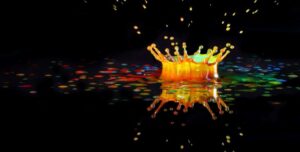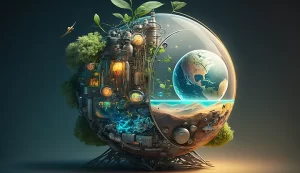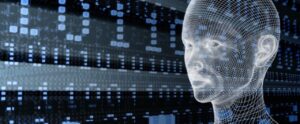“We are called to be architects of the future, not its victims.”
When Buckminster Fuller uttered these words, he knew that leaders would need to be inspirational, visionary and bring a creative mindset rather than being reactionary to the circumstances. Over the past couple of months, we have dedicated our energy to supporting leaders and organizations in building capacity for their teams and planning strategically for 2021 amid COVID, natural disasters, and overall times of VUCA (Volatility, Uncertainty, Complexity, Ambiguity).
We are especially interested in bringing to light the voices of wise leaders who have the experience and perspective that Buckminster Fuller called forth. Herman Gyr, the co-founder of Enterprise Development Group, is a world-renowned expert and speaker on strategic thinking and business transformation. In this interview, we get to the heart of connecting leaders to the future by learning the lessons of the signals that are coming in and understanding whom they need to be to enroll others in creating a new narrative.
What are the current signals leaders need to be aware of right now?
1. Digital Technology Still Has Impact
There has been this increasing awareness now for quite some time that a significant shift is ahead of us. Joanna Macy called it “The Great Turning“. In our work with organizational transformation, we describe this as a possibility. And sure enough, new advances, such as digital technology kept impacting companies so that they had to rethink their strategies and their products. Some companies didn’t think much about it because, despite disruptive developments, they were still doing well enough by basically staying the course. Part of our work at Enterprise Development Group was to convince our clients that they needed to adapt to these shifts more actively. We introduced them to think tanks, startups, brought them to Silicon Valley, and showed them tangible expressions of what we called “signals of the future.”
2. Covid As A Disruptor
Then COVID hit, and all of a sudden something that we had been contemplating, that scientists had been talking about, and that government had spent time preparing for, became very real. Everything was all of a sudden up in the air, and everybody ended up pretty much in the same soup. We no longer had to convince people that something transformational was going to happen, because it did happen abruptly, and for everyone to see.
COVID, of course, is a signal for something significant. It’s a natural phenomenon. It’s a natural organism that is impacting us and is a precursor to all the other natural things that are coming our way. While modern humanity has been transformed again and again by technological developments, from now on, it will be transformed by natural forces. Thus my notion that COVID is just a precursor to what is yet to come.
3. Our Own Self Reflection
The combination of these instantaneous realities, which has put us into a moment of crisis, reaction, and discovery of our strengths and weaknesses has enormous implications for leadership. At the moment, we’re in this in-between zone where the old is no longer holding, and the new hasn’t been created. Bill Bridges called it the neutral zone, the zone of not knowing, having to let go and not yet stabilised in some new normal. Thankfully we already have innovative models that may offer us new arrangements, such as the doughnut economy, circular economy, cradle to cradle. Now they get to play center stage to the Great Reset.
Now is the time to take another look at these constructs and ask: does this particular model have the inherent strength, the capability to be applied at scale? Could this be the framework that helps us arrange ourselves, our enterprises and institutions in ways that allow us to be successful as companies, as a society even, in a profoundly different world?
4. Change Is Already Happening
There are groundswell versions of this, governance versions, and corporate versions. Take Walmart for an example. Fifteen years ago, they declared their commitment to sustainability practices and moving to renewable energy. That was a first shift towards realizing that we all have to do something about our climate reality and that Walmart had a vital role to play in this. Recently President and CEO Doug McMillon announced that they will now be going beyond sustainability and adopting regenerative practices throughout their supply chain, as sustainability is not enough. These are some of the encouraging signals I see from companies and governments.
How do we support leaders to connect to the future they are creating?
1. Create The Future – Storytelling In Action
There are several things we can do. One is to join their efforts and help them establish a new narrative and a new story. Humans have always been engaged by a story that defines or creates a certain kind of reality. Our old stories guided us to where we are today. The story of modern human civilization has been formed significantly around our capacity to harness the power of technology. Still, now the existing industrial era mythology is on the way out and is being replaced by new mythology. So part of the work is to help create a new story in a credible form like what Walmart and Microsoft are doing – they are legitimizing our new story.
2. Join Forces
We have to work with leaders everywhere to clarify and stabilize a story that more effectively addresses today’s signals, today’s realities. Our glaciers are melting; the oceans are rising. Those are real signals. Agriculture is no longer viable because we’re destroying the organisms in the ground. That’s another signal.
Leaders need to shift from merely focusing on getting the current tasks done, and instead focus on creating a liveable future, and figuring out the story of how we will get there, together.
Who do leaders need to become to work in this transforming world?
This new kind of leadership needs to be born out of humility and respect. Leaders need to realize that we’re on this mission together and that it’s about mastering a world that we don’t fully understand. It’s a different way of being, and what I find is that it’s a wonderful way of being. It’s a fundamental human trait to be discoverers; we thrive on figuring stuff. You don’t have to know everything, but you can take responsibility for getting this new work done. Which brings me back to storytelling: leaders can play a critical role in joining with their stakeholders and co-create the future story.
What steps can leaders take to become this type of model leader?
Leaders need to learn how to map the future through ongoing storytelling and conversations with critical stakeholders. This starts by identifying and continuing to discuss the signals that are coming in from the external environment, from the world around us.
Ask questions like
- What’s happening in the world?
- How are we connected to the changes we see?
- How does this impact what we do?
- Does this change our products or services?
These are questions about what we do and more importantly about who we are as an enterprise.
Understanding this then makes it possible to look at the organization and its designs as well:
- Do our structures and processes need to change?
- What about our capabilities and skills?
- Any impacts on our values and culture?
In the best case this becomes an ongoing conversation that helps an enterprise effectively align itself with the changing realities it finds itself in over and over again, becoming what we call a dynamic enterprise. To continuously adapt by engaging everyone in this creation process.
Once this orientation of mapping the future is embedded in an enterprise, both in terms of its business and its organization, then you can have that conversation whenever it’s right. For example, Google has TGIF, Thank Google It’s Friday, where they get together every week, and thousands of people join in to have a conversation about where they are that week. It’s basically a weekly mapping process. Everybody is oriented to the same story and is participating in actually creating it. This gives people a sense of mastery, even if the world is challenging or even chaotic.
What are your five steps for regenerative business?
I was in a conversation just a few days ago with Josef Aschbacher, the head of the European Space Agency for Earth Observation, and Torsten Welte, the VP for Aeronomics from SAP. In the conversation, it became clear to me that there are five straightforward steps that companies need to follow to become regenerative enterprises:
Step 1: Understand your carbon footprint.
Step 2: Figure out your carbon legacy footprint.
Step 3: Communicate it to your critical stakeholders.
Step 4: Clarify actions and immediate next steps
Step 5: Make significant investments and participate in the creation of the solutions.
These five steps represent one of the narrative structures of a regenerative enterprise. They frame the tasks required for active engagement of stakeholders, and they frame the efforts required for an enterprise to shift into the regenerative economy. First, the enterprise has to be clear about its existing carbon footprint. It needs to be unabashedly open about it, thus engendering a sense of responsibility among all involved. Second, it needs to be honest about what legacy responsibility it has, how much of the legacy load of CO2 in our global atmosphere it “owns.” By openly communicating this to all critical stakeholders, it underscores its sense of responsibility and its commitment to act. And because many of the solutions are not yet known, it commits to actively supporting developmental efforts – together with others.
We increasingly understand that we all must actively participate in creating the regenerative era. That this is fundamental for the survival of life on our planet. Leaders increasingly know that they must take up the challenge and move their companies to become regenerative enterprises. As Mark Carney, the Head of the Bank of England, suggests: “Companies that ignore the climate crisis will go bankrupt.”
I would be so happy if people would engage with us to reflect on these five steps and enrich them. That would be a marvellous outcome from our conversation. To expand our understanding of the basics for creating a regenerative enterprise.
Herman Gyr, Ph.D. is a founding partner of the Enterprise Development Group and co-creator of the Innovation Blueprint, a model for engaging leaders and other stakeholders in the transformation of their enterprise. In projects ranging throughout the United States and Europe to Asia, South America and South Africa, Herman has specialized in working with enterprises living through periods of dramatic disruption – many of them underestimating the potential for achieving their highest aspirations during periods of change. He is co-author of The Dynamic Enterprise: Tools for Turning Chaos into Strategy and Strategy into Action and is a frequent invited speaker and workshop leader around the world on strategic thinking and business transformation in the regenerative era.
Maya Zuckerman is a Regenerative Entrepreneur, operations maven and emerging technology aficionado who applies the power of narrative, technology and regenerative design to world-changing ideas.
Her career has spanned tech-startups, cleantech, regenerative design, film, video games and multiplatform projects.
Her current projects and endeavours:
- Luman.io – COO – innovation and human capital strategy firm
- Global New Mobility Coalition – World Economic Forum project – content advisor
- IEEE – Ethically Aligned Design – co-chair for the Diversity and Inclusion committee – ethics for AI/AS (volunteer position)
- Innovation, Enterprise and Circular Economy MBA – currently enrolled – Bradford University – MBA was developed in partnership with the Ellen MacArthur Foundation
- Regennabis – Advisor – driving the SDGs in the Cannabis and Hemp industries
- RSA Fellow
- Solar Punk SciFi Writer
Kat Nadel is an expert in communication and empathy. She lights up when she’s supporting busy professionals to change the way they do business, from transactional to more personal.
Schedule time with us today to find out how you can connect your leaders to the future.





